Posted on
July 16, 2011 by
Dean Hybl
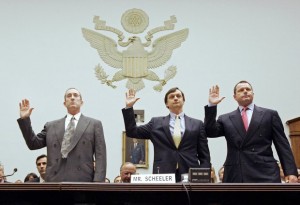
Roger Clemens was on trial for lying during a 2008 Congressional hearing.
Given that the “Steroid Era” in baseball has been built on a series of lies, accusations and uncertainties, it seems almost normal for baseball’s darkest era to come to an end with a mistrial in a federal courtroom that accomplished nothing and left as many questions as answers.
Ever since baseballs started flying out of stadiums at uncanny rates beginning in the early 1990s, the game of baseball has been in a civil war between those who believe in preserving the history and sanctity of the sport and those who saw the opportunity for greater success through artificial means.
This battle has left baseball with nearly two decades of inflated statistics and history that no one really knows what to do with.
Baseball purists have always pointed to the purity of statistics as being one of the components that make baseball special. For generations they contended that you could directly compare the statistics of players like Joe DiMaggio, Tris Speaker and Lou Gehrig with Hank Aaron, Willie Mays and Sandy Koufax to legitimately determine the greatest players of all-time.
Now in reality that argument is unsupportable as each era has its own nuances that make it difficult to compare with other generations.
Frank “Home Run” Baker earned his nickname by leading the American League in home runs four consecutive years between 1911 and 1914. During those four seasons, he blasted a combined total of 42 home runs, including 9 to lead the league in 1914. Yes, NINE! He finished his 13-year career with 96 home runs and 103 triples.
Just a few years later, a giant lefthander pitcher named George Herman “Babe” Ruth switched from being one of the American League’s most dominant pitchers to being its greatest slugger. He led the AL with 11 home runs in just 95 games in 1918 and in his first full season playing in the field in 1919 set a new single season record with 29 home runs. He hit 54 home runs in 1920 and 59 the following year and in 1921 became MLB’s career a home run leader, a distinction he would hold until 1974. Read the rest of this entry →
Tags: Jose BautistaMajor League BaseballMark McGwireRoger ClemensSammy SosaSteroids
Category
Baseball, Sports History
Posted on
July 09, 2011 by
Dean Hybl
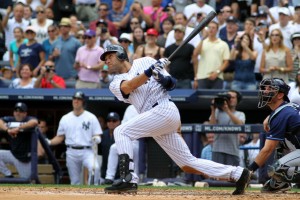
Derek Jeter is only the 28th player in baseball history to reach 3,000 career hits.
Given how much money they have spent to acquire the best players from across baseball over the last century, it is ironic that the first player to reach 3,000 hits as a member of the New York Yankees has spent his entire career in Yankee pinstripes.
It didn’t take Derek Jeter long after coming off the disabled list last Monday to get the last six hits needed to reach the prestigious milestone. With a home run in the third inning Saturday against the Tampa Bay Rays (part of a 5-hit day that also included the game-winning RBI), Jeter became the first player to reach 3,000 hits since Craig Biggio in 2007 and joined Wade Boggs as the only players to hit a home run to reach the plateau.
It is likely that the next player to reach 3,000 hits will also be a Yankee as Alex Rodriguez is within reach at 2,762 career hits. Though a pair of future Hall of Famers, Ivan Rodriguez (2,842 hits) and Omar Vizquel (2,831) are currently ahead of A-Rod, both are nearing the end of their careers and seem unlikely to stick around long enough to join the club.
Now that he has become the 28th player in baseball history to reach this milestone, it is interesting to analyze where Jeter stands in the pantheon of Yankee and all-time greats. Read the rest of this entry →
Tags: 3000 Hit ClubDerek JeterMajor League BaseballNew York Yankees
Category
Baseball, Great Moments, Sports History
Posted on
June 15, 2011 by
A.J. Foss
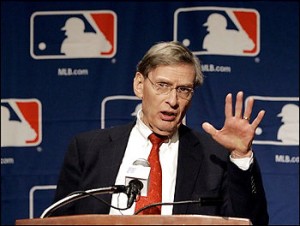
MLB Commissioner Bud Selig is considering a proposal that have two 15-team leagues and add two teams to the postseason.
Major League Baseball is reportedly discussing a plan to realign the American and National League, by sending a team from the 16-team National League to the 14-team American League, to even up the two leagues at 15 teams each.
The plan also calls for abolishing all divisions and adding a 5th team to the playoffs in both leagues.
To quote Jeff Goldblum in The Lost World: Jurassic Park, this realignment plan is the worst idea in the long, sad history of bad ideas.
The first issue is how to schedule the regular season. With 15 teams in each league, there would have to be one team that takes a few days off while the other 14 teams in each league play each other in a three-or-four game series.
Yes, the baseball season is a grind, but fans are used to watching their teams playing every day of the week and could easily forgot that their team is on the field playing a game if they had more than one day off. Read the rest of this entry →
Tags: Baseball RealignmentMajor League Baseball
Category
Baseball
Posted on
May 11, 2011 by
Dean Hybl
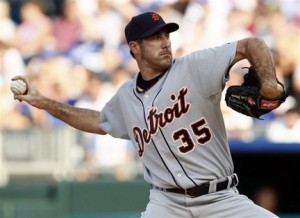
Justin Verlander tossed the second no-hitter of the season last Saturday.
The Major League Baseball season is barely a month old and it is already clear that the pitching dominance that was evident a year ago is going to stick around for a while. In fact, if 2010 was known as the “Year of the Pitcher”, 2011 looks to be “Year of the Pitcher – Part 2” and unlike most movie sequels where the second attempt usually falls short of the original, this sequel might be even greater than the first one.
The no-hitters thrown during the last week by Francisco Liriano and Justin Verlander offer just a taste of what could be an unlimited amount of pitching excellence.
When analyzing the numbers, it really is amazing how drastic offensive performance has declined across major league baseball over the last five years and is now more in line with what was seen 20 years ago and in some cases as far back as the pre-designated hitter era.
That leads to the question of whether what is being experienced is really a case of the quality of pitching rising to greater heights or merely a re-balancing of the game to where it would have always been had it not been for the performance enhancing drug era.
But whatever the reason, there is no denying that the statistics for pitchers are improving and those for hitters are declining.
Consider that so far in 2011 the average number of runs scored per team per game is 4.19 and the league-wide batting average is .249. The last time the league-wide average for runs per game was comparable was in 1992 when the average was 4.12 and the league-wide batting average was .256. The league-wide Earned Run Average (ERA) was 3.75.
Just two years later, in what is considered to be the start of the steroid era in 1994, the league-wide average jumped to 4.92 runs per team per game and the league-wide batting average was .270. The ERA for the league also jumped to 4.51.
Just as recently as 2006, teams were averaging 4.86 runs per game with a .269 average while the league-wide ERA was 4.53.
After a league-wide ERA of 4.08 a year ago, the best in the league for a season since 1992, hurlers across baseball are on pace this season for an ERA of 3.82.
If the current league-wide batting average of .249 continues for the entire season, it will be the first time since 1972 when the league had an average below .250. During that season, the league hit .244 while teams averaged 3.69 runs per game and .65 home runs per game. Read the rest of this entry →
Tags: Francisco LirianoJustin VerlanderMajor League Baseball
Category
Baseball, Great Moments, Sports History
Posted on
April 17, 2011 by
Dean Hybl
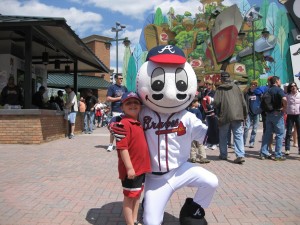
Nate made lots of friends during his first Major League baseball experience.
As a lifelong baseball fan I know that while it is great to watch the game on television or listen to a radio broadcast, there is nothing quite like going to a ballpark to experience it in person.
No matter how many games you have attended, there is something special about being in one of baseball’s grand cathedrals to watch the best players in the world participate in America’s Pastime.
However, there is nothing like experiencing the thrill for the first time.
I have been blessed over the years to have spent many great days at ballparks with my parents, brothers and other friends, so I was thrilled this week to have the opportunity to share my passion for baseball with my five-year-old son Nate as he made his first trip to a Major League Stadium on April 16th to see the Atlanta Braves host the New York Mets at Turner Field.
Thanks to great hospitality from a long-time friend and the wonderful atmosphere, amenities and staff at Turner Field, his first Major League experience was an amazing day that he thoroughly enjoyed at the time, but I expect he will appreciate even more as he gets older and realizes just how special his day was.
Even though I have had the great fortune to work at professional stadiums on a regular basis during my career, it is still a neat experience to be driving down a road and suddenly have a grandiose stadium emerge from seemingly out of nowhere.
Since this was Nate’s first trip to Atlanta, just seeing all the big buildings and extravagant roadways was excitement enough, but to see such a large stadium suddenly appear along the road was quite exciting. Nate has been to the very nice minor league stadium in Greenville, South Carolina, but Turner Field takes the experience to a completely new level. Read the rest of this entry →
Tags: Atlanta BravesChipper JonesFredi GonzalezMajor League BaseballNate Hybl
Category
General
Posted on
December 11, 2010 by
Dean Hybl
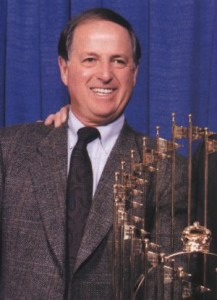
Pat Gillick in the first pure general manager from the last 50 years of baseball to be selected for the Baseball Hall of Fame.
The election earlier this week of Pat Gillick to the Baseball Hall of Fame was a deserving honor for a longtime baseball executive, but the Veterans Committee missed a chance to make the 2011 Hall of Fame class truly special.
Recognizing baseball front office personnel who were not owners or league officials is not one of the traditional strengths of the Baseball Hall of Fame. Gillick is the 32nd baseball executive honored by the Hall of Fame, but only the fourth whose primary responsibilities was as a general manager or team architect and the only one from the last 50 years of baseball.
While other general managers have received more publicity, few in the modern era of baseball have had more success than Gillick.
After beginning his career with the fledgling Houston Astros and then having a stint in the front office of the New York Yankees in the 1970s, it was after joining the expansion Toronto Blue Jays that Gillick began establishing his Hall of Fame credentials.
Originally hired in 1976 as the Vice President of Player Personnel, in 1977 he became Vice President of Baseball Operations and in 1984 named the Executive Vice President of Baseball Operations.
Overseeing the development of the roster from expansion, Gillick crafted a roster that was built through the development of minor leaguers and then enhanced with savvy veteran acquisitions.
The Blue Jays posted their first winning record during their seventh season (1983) and two years later won 99 games and reached the AL Championship Series for the first time. They also won the AL East in 1989 and 1991 before claiming back-to-back World Series titles in 1992 and 1993. He left the organization in 1994 and the franchise has not reached the post season since.
In 1995 Gillick became general manager of the Baltimore Orioles and in 1996 and 1997 the team reached the AL Championship Series. The Orioles have not had a winning season since his departure in 1998. Read the rest of this entry →
Tags: Baseball Hall of FameMajor League BaseballPat Gillick
Category
Baseball, Sports History





